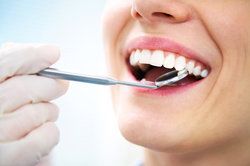In-office vs. At-home Teeth Whitening
 Teeth whitening is one of the fastest and easiest ways to improve your appearance. It is so commonplace, you may think there is no reason to talk with your dentist. But you shouldn’t go it alone.
Teeth whitening is one of the fastest and easiest ways to improve your appearance. It is so commonplace, you may think there is no reason to talk with your dentist. But you shouldn’t go it alone.
Even if you opt for at-home whitening treatments, you should have your teeth checked before you begin. If you have a cavity or even just a loose filling, the whitening agent can seep into the interior of your tooth. Not only can this cause extreme pain, it can also damage the tooth’s root, perhaps requiring a root canal treatment.
Dr. Wayne Myles in Reston can ensure your teeth are healthy before you undergo teeth whitening. And, if you are overwhelmed by all the whitening options, he can recommend products or treatments suitable for you. He can also recommend cosmetic dentistry treatments if your teeth are not suitable for standard teeth whitening treatments.
In-Office Treatment
The main difference between at-home and in-office treatments is the strength of the whitening agent; stronger whiteners mean fewer or shorter treatments. The strongest and fastest whiteners are available at your dentist’s office. While it might take several weeks using at-home treatments to get your teeth whiter, dentists are able to whiten teeth as much as eight shades brighter in an hour.
In-office treatments can use stronger whiteners because the dentist supervises the treatment to ensure safety. This is particularly important for people who have sensitive teeth or gums. A dentist can modify the treatment to ensure the best possible whitening without damage.
In addition to in-office treatments, dentists offer professional at-home treatments with trays custom molded to your teeth. Custom trays are key in keeping the whitener in close contact with teeth for the best results. At the same time, a custom fit reduces the chance that the whitening gel will escape and irritate gums.
But the speed and supervision of in-office treatments have a drawback: They cost more.
At Home Treatment
At-home treatments are also effective, and cost much less. However, the whitening agents in at-home treatments are not as strong, so it may take several treatments over a longer period to attain the whiteness you desire.
Popular at-home treatments use whitening strips, which affix to teeth, or trays that hold the whitening agent. Both methods are inexpensive and convenient. You can whiten your teeth whenever you have time.
Of course, over-the-counter trays cannot provide as close a fit as the ones your dentist creates using your teeth as a mold. With generic trays, the whitener may not have good contact with the teeth, reducing its effectiveness. There is also a greater chance gel will leak out, irritating your gums. If you have sensitive gums, this may be important.
A main disadvantage with at-home treatments is that you are on your own. Safe use of whiteners requires that you follow directions exactly to avoid harming your teeth or gums. This is even more important if your teeth are not in optimum health.
If you are considering whitening your teeth, follow the American Dental Association’s recommendation to have your teeth checked to avoid complications.
Dr. Myles would be happy to ensure your teeth are healthy enough for whitening and can recommend treatments that will work for you. Please call for an appointment.


